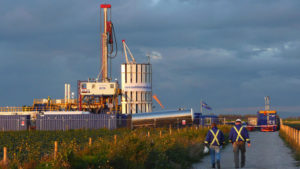by WorldTribune Staff, March 23, 2017
As the world economy grew last year, global carbon dioxide emissions remained flat for a third year in a row, raising questions of whether the UN Paris climate agreement is necessary, a report said.
The success of the shale gas industry, or fracking, paved the way as the United States saw carbon dioxide emissions fall to their lowest level since 1993. Emissions fell by 3 percent in the United States as the economy expanded by 1.6 percent, according to the International Energy Agency (IEA).

The IEA’s findings reignited criticism of the Paris Agreement, which President Donald Trump promised to dismantle during last year’s campaign. Former President Barack Obama entered into the accord in September without Senate ratification.
“Who needs EPA regulations or UN treaties to reduce carbon dioxide emissions?” said Climate Depot publisher Marc Morano, an opponent of the Paris accord.
“Emissions are slowing due market forces, technology driven efficiency and of course — fracking.”
Morano added that if “climate activists were intellectually honest, they would be singing the praises of fracking as the most effective way to reduce emissions. Fracking has put the UN climate agreement out of business.”
While demand for coal fell worldwide, “the drop was particularly sharp in the United States, where demand was down 11 percent in 2016,” the IEA said. “For the first time, electricity generation from natural gas was higher than from coal last year in the United States.”
The IEA released a study on March 17 that showed emissions from the industrial sector in 2016 measured at 32.1 gigatonnes, the same amount as the previous two years, while the global economy grew by 3.1 percent, The Washington Times reported on March 21.
“These three years of flat emissions in a growing global economy signal an emerging trend and that is certainly a cause for optimism, even if it is too soon to say that global emissions have definitely peaked,” IEA executive director Fatih Birol said in a statement.
“They are also a sign that market dynamics and technological improvements matter,” Birol said. “This is especially true in the United States, where abundant shale gas supplies have become a cheap power source.”
China, the world’s largest carbon dioxide emitter along with the United States, saw emissions fall by 1 percent and the economy expand by 6.7 percent, while Europe remained “largely stable” as coal demand dropped by 10 percent and gas increased by 8 percent, the IEA study said.
Supporters of the Paris Agreement have argued that the recent emissions stability represents a promising beginning but that the trend needs to be reversed.
“We now need to turn this no-growth to actual declines in emissions as soon as possible,” said four climate scientists in a Nov. 13 post in the Conversation. “Otherwise, it will be a challenge to keep cumulative emissions below the level that would avoid a 2℃ warming, as required under the Paris Agreement.”
